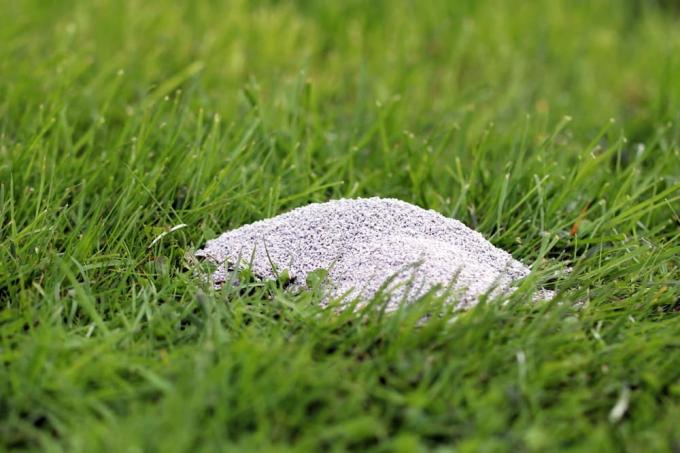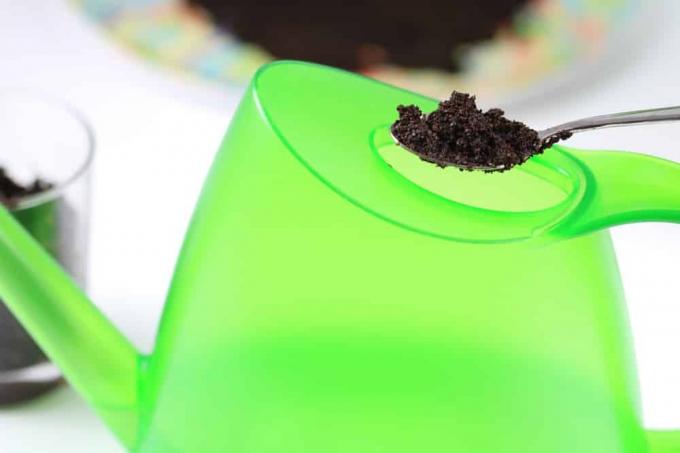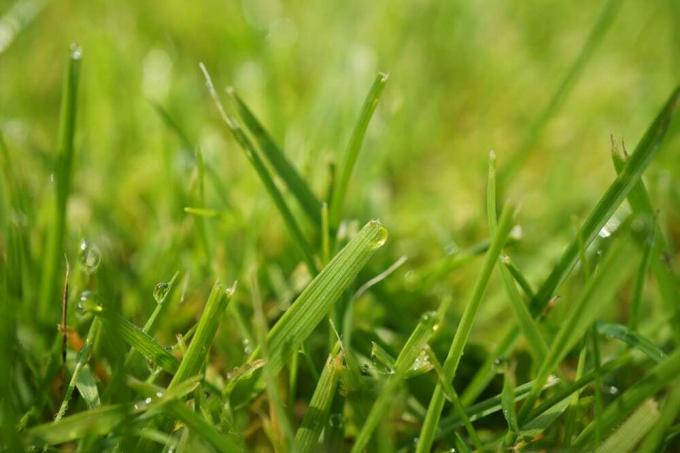

Table of contents
- Why fertilize with lime
- Recognizing acidic soil
- Consider the needs of the plants
- The right dosage
- Lime fertilizer for the lawn
- The right time
- Overview of different lime fertilizers
- rock flour
- garden lime
- quicklime and slaked lime
- lime marl
- algae lime
- Conclusion
In order to ensure a beautiful green garden and a bountiful harvest, fertilizer lime must be used from time to time. This is usually done by the actual fertilization measures and must not be used as the only fertilization alternative. Because the lime fertilizer only prepares the soil for regular fertilization, which should take place a few weeks later. So if the soil is too acidic, it needs lime to become neutral again. However, if too much lime is used, humus is broken down. Therefore, it is important to observe exact quantities during lime fertilization.
Why fertilize with lime
Lime neutralizes the pH value in the soil, but only if it is used purposefully and reasonably sparingly. But then many successes can be achieved. Acidification of the soil, which gradually occurs over the years, is also prevented if lime fertilizer is supplied from time to time, not every year. In addition, the lime binds the clay present in the earth and last but not least promotes the activity of microorganisms. If a nutrient-rich fertilizer is used after lime fertilization, the plants can also absorb the nutrients better. Because the combination of the lime with the clay crumbs improves the soil structure as a whole, which also means better storage of air and water. This also allows the earth to warm up faster in spring and the soil does not silt up as quickly.
Tip:
If too much lime is used as fertilizer, the soil loses humus. Many nutrients are released at first, but in the long run the soil is leached out and the storage capacity for other nutrients, air and water decreases. Therefore, when fertilizing, you should always pay attention to the correct dosage.
Recognizing acidic soil

Many laboratories already offer to analyze the soil quality of your own garden soil for little money. For this purpose, soil samples are taken from various locations and sent to the selected laboratory. Based on the values that result from this, the hobby gardener can see whether the soil is too acidic and should therefore be subjected to lime fertilization. But different plants can also indicate whether the soil in the garden bed or lawn is acidic. If the following plants grow in different places in the garden, the soil is too acidic and action should be taken:
- hare and wood sorrel
- field horsetail
- pansies
- sorrel
- dog chamomile
- Growth disturbances in garden plants are also an indication
- young, yellowing leaves
- dried tips on young shoots
- Blossom rot in tomatoes
- brown spots in the flesh of apples
Tip:
If no soil analysis is to be sent in for security purposes, the soil itself can also be examined with a test set from a well-stocked shop. However, this only provides a rough estimate of the soil conditions.
Consider the needs of the plants
Not every plant in the garden is unhappy with slightly acidic soil. Therefore, you should not fertilize the entire garden with lime, but pay attention to the different requirements of the individual plants. In any case, vegetable beds and lawns require regular lime fertilization, as do flower beds with perennial plants. Eria plants such as rhododendrons or hydrangeas, summer heather and camellias do not tolerate any lime.
The right dosage
The right dosage is important in order not to overcalcify the soil and thus harm the plants rather than help them. It is therefore important for every good hobby gardener to know what the garden soil needs. Since many private and state-funded laboratories already offer soil analysis, which is also not expensive, this should definitely be used. This is the only way to recognize when the soil falls below the pH limit of 5.5 to become acidic soil. Then it can be dosed and fertilized with lime as follows:
- carry out maintenance liming if the limit values are slightly undershot
- To do this, sprinkle about 150 grams of carbonate of lime every three years on one square meter
- if the values are significantly lower, more must be spread
- increase the pH value in sandy soils
- 250 grams per square meter are required for one step
- Clay soils even need twice the amount for a pH increase
- Clay soils are ideally fertilized with burnt lime
Tip:
However, if a lot of lime is required per square meter because the soil is very acidic, there is no point in applying the entire amount of lime required in one go. In such a case, it is better to fertilize with lime on two dates about six months apart and to take another soil sample after about another six months.
Lime fertilizer for the lawn
The lawn can also use lime fertilization from time to time, since the soil can also become acidic here due to too much moisture or backwater. Then the lawn also turns yellow and loses its rich green. But it should always be borne in mind that clover, for example, is also very fond of lime and therefore clover could spread on the beautifully manicured lawn. It is therefore advisable not to lime the lawn too often and to ensure that the pH value is below 5.5. Anything above that is good and the floor doesn't need to be whitewashed. When liming the lawn, you should therefore proceed as follows:
- scarify before fertilizing
- don't count on "good luck" and observe the quantity guidelines
- do not give at the same time as lawn fertilizer
- there should be several weeks between the different fertilizer doses
Tip:
Whether for the application of lime on the lawn or on the garden bed, it is advisable to use a spreader. This guarantees that the same amount of lime is applied to every part of the floor. If you don't want to buy such a spreader, you can also find it for daily rental in well-stocked garden shops.
The right time

Spring is the ideal time to lime the garden beds and the lawn. However, several aspects should be taken into account here:
- the ground must be dry
- if lawns or perennial beds are whitewashed, the sky should be overcast
- Sun exposure can burn the roots of plants
- do not lime at the same time as you add stable manure
- because this is how the nitrogen, which is important for the plants, escapes into the air
- if the spring deadline was missed, lime can still be used in autumn
Overview of different lime fertilizers
Lime is a calcium compound that occurs naturally in many different types of rock. Most commercially available lime fertilizers are based on the raw material calcium carbonate obtained from this. The following lime fertilizers can be bought in stores and are ideal for fertilizing garden beds and lawns with lime:
rock flour
- In addition to calcium carbonate, it also contains potassium and magnesium
- can be mixed with compost
- a pure lime fertilization is not necessary
garden lime
- suitable for autumn and winter
- ground limestone, often difficult to dissolve
quicklime and slaked lime
- is mostly used in agriculture on heavy soils
- only use for your own garden on very loamy soil
lime marl
- ideal for sandy soils
algae lime
- is made from coral deposits
- is particularly suitable for fertilization in spring and summer
Conclusion
Lime fertilization should only be used when it is really necessary, and that is not the case every year. It is therefore important to have the soil analyzed for its pH value and, based on the result, to decide whether or not to fertilize with lime. However, lime fertilization never replaces regular fertilization with nutrients and should always be administered a few weeks in advance. Lime fertilization also strengthens a healthy lawn. But not all plants like a neutral soil, which is made possible by lime fertilization. In these cases, fertilization with lime should generally be avoided.
 garden editorial
garden editorial I write about everything that interests me in my garden.
Learn more about fertilizer

Lawn lime: Lime against moss in the lawn
As soon as moss appears in the lawn, many a hobby gardener becomes restless - because soon the moss carpet can take over entire areas. With lawn lime, however, the unwelcome visitor can be skilfully put in his place.

Build your own Bokashi bucket | DIY instructions
Most of the kitchen waste goes on the compost or in the organic bin to add it back to nature's cycle. But there is a way to gain valuable fertilizer beforehand. We show how easy it is to build a Bokashi bucket and use it to obtain liquid fertilizer on the balcony or even in the apartment.

These 8 plants don't like coffee grounds as fertilizer
Hobby gardeners swear by the effect of the coffee grounds. It is fertilizer, snail protection, soil conditioner and cat deterrent all at the same time. In addition, it is free of charge and occurs daily in the household. Most plants are strengthened, but some are sensitive to the addition of coffee. We clarify.

Fertilize Christmas roses properly: 11 effective home remedies
Christmas roses are special flowers because, unlike almost all other perennials, they bloom in winter. They are insensitive and frost-hardy, and they can also multiply independently. Here you can find out what needs to be considered when fertilizing.

Lawn Bokashi: 6 steps to a cheap & natural fertilizer
The name Bokashi is still largely unknown. This method of using grass clippings comes from Japan. With a little preparation and a special form of processing, the clippings become valuable, nutrient-rich fertilizer that can be easily distributed in the garden.

Wood ash as fertilizer | These 70 plants love barbecue and charcoal
Home gardeners with a fireplace or tiled stove receive a natural fertilizer for free. Charcoal and charcoal leave behind a dusty residue that is packed with valuable nutrients. Read here under what conditions wood ash is suitable as a fertilizer. These 70 plants benefit from the unorthodox nutrient supply.



